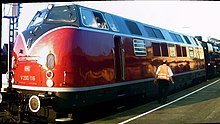Merkur(train)
 Class V200 | |
| Overview | |
|---|---|
| Service type | F-Zug (1953-1971) Intercity (1971-1974) Trans Europ Express(TEE) (1974–1978) Intercity (1978–1987) EuroCity (1987-1991) |
| Status | Discontinued |
| Locale | Germany Denmark |
| First service | 1 June 1953 |
| Last service | 1 June 1991 |
| Successor | ECKaren Blixen |
| Former operator(s) | Deutsche Bundesbahn Danske Statsbaner |
| Route | |
| Termini | Copenhagen Stuttgart |
| Distance travelled | 1,205 km (749 mi) |
| Service frequency | Daily |
| Technical | |
| Track gauge | 1,435 mm(4 ft8+1⁄2in) |
TheMerkurwas an internationalexpress trainlinkingCopenhagen,the Danish capital, withGermany.The train was named after the Roman GodMercury,the God of traders and travellers.[1]
F-Zug
[edit]In 1953 theMerkurwas introduced byDeutsche Bundesbahnas part of their long-distance network (Fern Zug). TheMerkur(F 3/4) linkedHamburgwithFrankfurt am MainviaCologneand through the Rhinevalley on the eastbank railway. In 1954 the route south of Frankfurt was extended toStuttgartand theMerkurbecame known for its long non-stop stages with steam locomotives.[2]
In 1971 the F-Zug network was converted to a firstclass only Intercity network and theMerkurwas assigned the trainnumbers IC 114/115. Another train of the F-Zug network, theSchwabenpfeil,(F 23/24) ran between Stuttgart andDortmundthrough the Rhine valley as well, but on the west bank of the Rhine, calling in the West-German capitalBonn.With the conversion to the Intercity network theSchwabenpfeilwas extended further north toHamburgas IC 110/119.[3]
Trans Europ Express
[edit]TheMerkurwas upgraded toTEEon 26 May 1974 as the service was extended north of Hamburg toCopenhagenover theVogelfluglinie.It was the only TEE service in Denmark and the only TEE using atrain ferryduring its journey. In order to connect the two capitals Bonn and Copenhagen theSchwabenpfeilwas withdrawn and theMerkurused its route and slot south ofHamburg.[4]BetweenStuttgartandHamburgthe train was hauled by class 103 electric locomotives, north of Hamburg the German diesel class 221 and the Danish diesel classes MY and MZ were used. The ferry fromRødbyFærge toPuttgardentook about 55 minutes, the loading and unloading about 5 minutes on each side. The longer stop at Rødby Færge was caused by customs inspection and not meant to let passengers leave or board the train. In order to cope with the language barrier the train had multilingual (Danish/German/English) stewardesses on board.[5]
Technical problems
[edit]Differences between Danish and German train operation caused some technical problems with heating and airconditioning. The electric power needed for the airconditioning couldn't be provided by the Danish locomotives so the batteries of the coaches had to be loaded during the crossing of the Fehmarn between Puttgarden and Rødby Færge. On the other hand, the steam heating wasn't operational in Germany any more, so the steamheating in the German coaches was in bad shape,[6]causing heating problems on the Danish side.
Catering
[edit]Neither theDeutsche Bundesbahnnor theGerman Sleeper and Dining Car Company(DSG) regarded a full dining car between Hamburg and Copenhagen as profitable. The TEE criteria however demanded on board catering so a minibar was introduced. As the alcohol duties in Germany and Denmark differed from each other it wasn't allowed to sell Danish alcohol in Germany and vice versa. This alcohol problem was solved by parking the national minibar in the customs house at the border. The Danish minibar was filled in Copenhagen and travelled to Rødby Færge where it was sealed and stored in the customs house and picked up by the return service to Copenhagen. The same occurred with the German minibar filled in Hamburg and stored in the customs house at Puttgarden. As a result, the only catering on board the ferry was coffee.[7]
Intercity
[edit]On 28 May 1978 the train was downgraded to an intercity service with 2nd-class coaches as well.[8]
EuroCity
[edit]In 1987 theMerkurbecame part of the newEuroCitynetwork. In order to tackle the low frequency of the TEE network, two more trains, ECHansaand ECSkandinavien,were introduced at the Vogelfluglinie, so three high quality services daily in each direction between Hamburg and Copenhagen were available for travellers. In 1991 it was decided to name the EuroCities after famous Danes and Germans, so the Merkur was replaced by theECKaren Blixen.[9]
References
[edit]- ^La Légende des TEEp. 358.
- ^TEE Züge in Deutschlandp. 127.
- ^TEE Züge in Deutschlandp. 127.
- ^Das grosse TEE Buchp. 90
- ^TEE Merkurp. 4.
- ^TEE Merkurp. 3.
- ^TEE Merkurp. 4.
- ^TEE Züge in Deutschlandp. 128.
- ^La Légende des TEEp. 360.
Works cited
[edit]- Hajt, Jörg (2001).Das grosse TEE Buch(in German). Bonn/Königswinter: Heel Verlag.ISBN3-89365-948-X.
- Mertens, Maurice; Malaspina, Jean-Pierre (2007).La Légende des Trans Europ Express(in French). Vannes: LR Presse.ISBN978-29-036514-5-9.
- Goette, Peter (2008).TEE-Züge in Deutschland(in German). Freiburg: EK-Verlag.ISBN978-3-88255-698-8.
- Raabe, Rainer (2008).TEE Merkur(in German). Zürich: TEE Classics.

